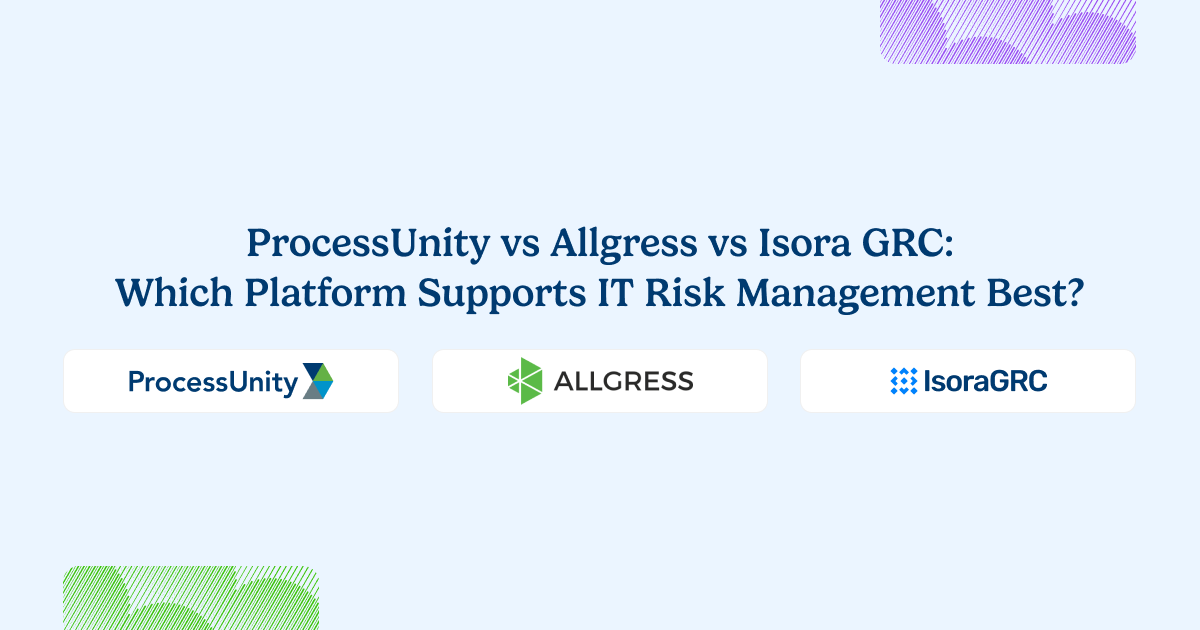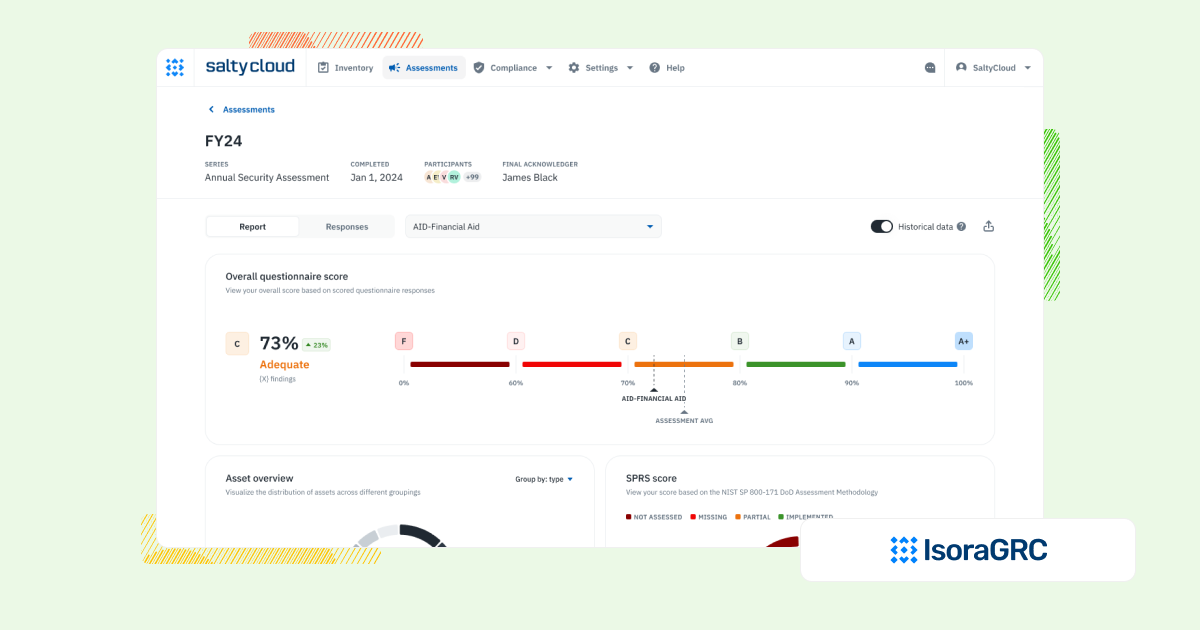
Every security team needs a structured, scalable way to manage IT risk—not just save money upfront.
Platforms like ProcessUnity and Allgress offer lightweight solutions that may seem like cost-effective choices at first.
While lightweight tools may look simple, they often lack the structure and scalability teams need to grow a real risk program.
Isora GRC redefines how risk management is done. It’s purpose-built for security teams who need to run assessments, manage inventories, and track risks—providing a comprehensive and scalable solution for long-term growth.
Let’s explore the details.
Choosing the Right Platform for IT Risk Management
ProcessUnity offers an extensive suite of features across enterprise risk and compliance—but that depth comes with complexity. Implementation timelines are long, workflows often require customization, and the platform can become difficult to manage without dedicated support. Allgress, by contrast, offers a more lightweight, lower-cost solution—but often lacks the maturity, flexibility, or scalability to support enterprise-wide risk programs.
Isora GRC finds the middle ground: a security-first platform that’s purpose-built for managing internal and vendor risk—without the bloat or oversimplification. It delivers structured workflows for assessments, risk tracking, exception management, and inventory oversight, with fast deployment and an intuitive interface that drives adoption across stakeholders.
The Workflow That Matters: Managing IT Risks and Compliance
Whether you’re a growing organization or a large institution with decentralized risk ownership, IT risk management depends on clear workflows, shared accountability, and repeatable structure. ProcessUnity may support these workflows in theory—but in practice, its complexity can limit responsiveness. Allgress may offer simpler workflows, but they’re often too rigid or limited in scope for teams with evolving needs.
Isora GRC gives teams a practical, usable system for conducting risk assessments, managing vendor and asset inventories, tracking remediation efforts, and documenting exceptions. With flexible templates, built-in collaboration features, and robust reporting, Isora helps teams operationalize risk management without being locked into either extreme.
How Each Platform Supports IT Risk Management Workflows
| Workflow Area | ProcessUnity | Allgress | Isora GRC |
| Assessment Management | Assessment tools exist but feel stiff. Automation is weak. Most steps still need manual input. | Only basic features exist. No strong tools for big teams. Automation barely helps. The system fits small use cases better. | Centralized, intuitive assessment dashboard across business units, vendors, and assets. Built specifically for security teams. |
| Questionnaire Delivery & Completion | Survey tools lack flexibility. The interface feels clumsy. Forms don’t connect well with other risk tools. | Survey tools feel weak. Custom options don’t exist. Teams find the system hard to use. | Customizable and prebuilt questionnaires for frameworks like NIST, ISO, GLBA, HIPAA, and more. Designed for internal and external collaboration. |
| Inventory Tracking | Asset tracking tools feel basic. Linking systems stays hard. Complex setups don’t work well here. | Asset tracking tools miss the mark. Few outside tools work with it. Complex tracking doesn’t run well. | Centralized tracking of assets, vendors, and organizational units with integration support for existing data sources. |
| Risk Register & Exception Management | The register helps but can’t adjust much. Exceptions take time to configure. Errors may happen during manual steps. | Risk tracking exists but stays limited. Manual work slows the process. No automation hurts speed. | Flexible, collaborative risk register with scoring, status, evidence, and ownership tied directly to assessments. Exception management is built-in and intuitive—no extra modules or configuration required. |
| Scoring, Reporting & Risk Visualization | Reports and visuals look basic. Custom reports take time. Navigating reports feels confusing. | Reports feel weak and hard to shape. Visual tools feel half-baked. Tech help may be needed to build good insights. | Automated scorecards, risk maps, and executive-friendly reports with actionable insights—no manual config required. |
| Collaboration & User Experience | Collaboration tools feel weak. Sharing across teams doesn’t flow well. Learning the system takes effort. | The interface stays hard to use. Teams struggle to share and work together. Workflows feel slow and messy. | WCAG-compliant, award-nominated interface with built-in commenting, team workflows, and fast onboarding. |
| Implementation & Setup | Setup can drag on. Special needs take extra time. Training adds more time and cost. | Setup takes time. Many steps need tech help. Teams must train before the platform works well. | No-code setup in days or weeks. Minimal IT lift required. Designed to go live quickly across teams and vendors. |
What Sets Isora GRC Apart?

Isora GRC was purpose-built for information security teams—designed to support the real workflows behind risk and compliance, not just generate reports. While legacy GRC platforms require months of configuration and rigid processes, Isora takes a modern, scalable approach:
- Purpose-built for security and third-party risk teams
- No extra modules or cross-department bloat—just the workflows that matter.
- Easy for anyone to use
- Clean UI, no complex training, and built to drive adoption across the org.
- Streamlined for action, not just documentation
- Assessments, questionnaires, inventories, risk tracking, and reporting—all in one place.
- Fast, no-code implementation
- Go live in weeks, not quarters, with minimal IT lift.
- Scales with your program
- Whether you’re running a lean risk function or supporting a large institution, Isora grows with you—without getting in the way.
Who Each Platform Is Best For
| Platform | Who It’s For |
| ProcessUnity | Teams focused mostly on vendor risk. Strong for third-party tracking, not built for full InfoSec programs. |
| Allgress | Small teams needing something fast and cheap. Doesn’t offer much depth or growth. |
| Isora GRC | Security teams that need a scalable, usable IT risk management program across their organization. |
What Our Customers Say About Isora GRC
Security teams at top institutions are using Isora GRC to replace legacy tools and manual processes with intuitive workflows and actionable insight.
“Moving from manual processes to using Isora was a breath of fresh air. What used to take months is now automated, reliable, and defensible. Isora saves us significant time while delivering accurate insights that improve decision-making.”
Jessica Sandy, IT GRC Manager, The University of Chicago
“Isora has been essential in helping us meet our University of California cybersecurity requirements across a decentralized campus. Automating assessment data collection and reporting has given us clear visibility into unit-level risks, enabling us to prioritize resources effectively and address gaps with confidence.”
Allison Henry, CISO, The University of California, Berkeley
FAQs
What’s the difference between ProcessUnity, Allgress, and Isora GRC?
ProcessUnity is an enterprise GRC platform often used for third-party risk and compliance workflows. Allgress is a lower-cost tool with basic functionality. Isora GRC sits in the middle—providing focused, powerful workflows for IT and vendor risk management without the bloat of all-in-ones or the tradeoffs of free tools.
Are ProcessUnity and Allgress considered GRC platforms?
Yes, but they serve different ends of the spectrum. ProcessUnity is highly configurable and enterprise-grade but can be complex. Allgress offers lightweight risk and compliance features but lacks the depth and structure needed for scalable risk programs. Isora GRC offers streamlined, security-focused workflows for modern teams.
Does Isora GRC replace tools like ProcessUnity or Allgress?
Yes. Isora GRC provides structured assessments, inventories, risk registers, and exception tracking in one cohesive platform—ideal for security teams who need usability, speed, and end-to-end visibility.
Which platform is best for managing IT and third-party risk workflows?
Isora GRC is purpose-built for security and vendor risk teams. It supports both internal and external assessments, integrates with inventory management, and makes it easier to operationalize remediation—all with minimal setup.
Can Isora GRC be used alongside ProcessUnity or Allgress?
It can, but most teams choose Isora GRC as a standalone platform when looking to simplify or scale. It replaces both bulky legacy tools and entry-level solutions with one platform that’s focused and extensible.
What should I look for in a GRC platform for scalable risk management?
Focus on ease of use, fast deployment, structured workflows, and broad adoption. Isora GRC helps teams move beyond checklists—supporting assessments, exceptions, inventories, and real-time risk visibility in one system.


















